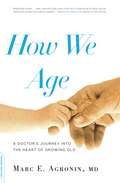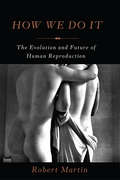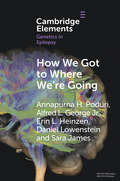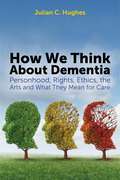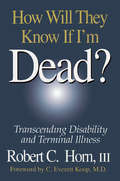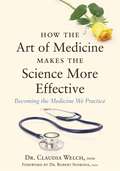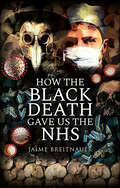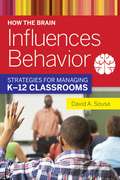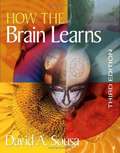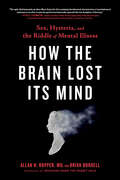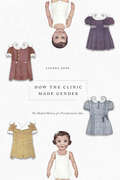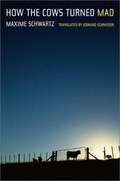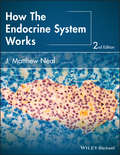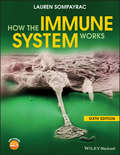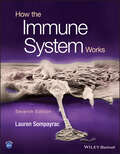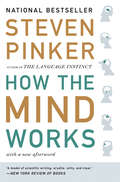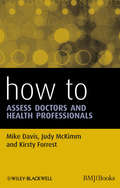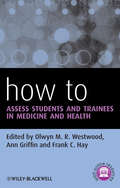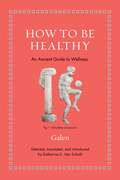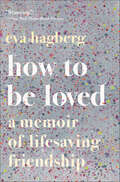- Table View
- List View
How We Age: A Doctor's Journey into the Heart of Growing Old
by Marc AgroninA young doctorOCOs reflections on his experiences as a nursing-home psychiatrist?with remarkable stories of vitality and growth that transformed his view of aging
How We Became Sensorimotor: Movement, Measurement, Sensation
by Mark PatersonAn engrossing history of the century that transformed our knowledge of the body&’s inner senses The years between 1833 and 1945 fundamentally transformed science&’s understanding of the body&’s inner senses, revolutionizing fields like philosophy, the social sciences, and cognitive science. In How We Became Sensorimotor, Mark Paterson provides a systematic account of this transformative period, while also demonstrating its substantial implications for current explorations into phenomenology, embodied consciousness, the extended mind, and theories of the sensorimotor, the body, and embodiment.Each chapter of How We Became Sensorimotor takes a particular sense and historicizes its formation by means of recent scientific studies, case studies, or coverage in the media. Ranging among a diverse array of sensations, including balance, fatigue, pain, the &“muscle sense,&” and what Maurice Merleau-Ponty termed &“motricity,&” Paterson&’s analysis moves outward from the familiar confines of the laboratory to those of the industrial world and even to wild animals and their habitats. He uncovers important stories, such as how forgotten pain-measurement schemes transformed criminology, or how Penfield&’s outmoded concepts of the sensory and motor homunculi of the brain still mar psychology textbooks.Complete with original archival research featuring illustrations and correspondence, How We Became Sensorimotor shows how the shifting and sometimes contested historical background to our understandings of the senses are being extended even today.
How We Do It: The Evolution and Future of Human Reproduction
by Robert MartinDespite our seemingly endless fascination with sex and parenting, the origins of our reproductive lives remain a mystery. Why are a quarter of a billion sperm cells needed to fertilize one egg? Are women really fertile for only a few days each month? How long should women breast-feed? In How We Do It, primatologist Robert Martin draws on forty years of research to locate the origins of everything from sex cells to baby care#151;and to reveal what’s really #147;natural” when it comes to making and raising babies. He acknowledges that although it’s not realistic to reproduce like our ancestors did, there are surprising consequences to behavior we take for granted, such as bottle feeding, cesarean sections, and in vitro fertilization. How We Do It shows that once we understand our evolutionary past, we can consider what worked, what didn’t, and what it all means for the future of our species.
How We Got to Where We're Going (Elements in Genetics in Epilepsy)
by Sara James Annapurna H. Poduri Daniel Lowenstein Alfred L. George Jr. Erin HeinzenThis Element serves as a welcome to the Cambridge Elements Genetics in Epilepsy series. The series editors look forward to sharing with you the story of epilepsy genetics through a series of Elements. They will bring together many voices, by text as well as video, to illustrate the history of epilepsy genetics, the many on-going efforts in the field, and how they hope to address the still unanswered questions that command the attention of all of us and our colleagues across the globe.
How We Think About Dementia: Personhood, Rights, Ethics, the Arts and What They Mean for Care
by Julian C. HughesExploring concepts of ageing, personhood, capacity, liberty, best interests and the nature and ethics of palliative care, this book will help those in the caring professions to understand and engage with the thoughts and arguments underpinning the experience of dementia and dementia care. Dementia is associated with ageing: what is the significance of this? People speak about person-centred care, but what is personhood and how can it be maintained? What is capacity, and how is it linked with the way a person with dementia is cared for as a human being? How should we think about the law in relation to the care of older people? Is palliative care the right approach to dementia, and if so what are the consequences of this view? What role can the arts play in ensuring quality of life for people with dementia? In answering such questions, Julian Hughes brings our attention back to the philosophical and ethical underpinnings of dementia care, shedding new light on the significance and implications for those in the caring professions, academics and researchers, and those living with dementia and their families.
How Will They Know If I'm Dead?: Transcending Disability and Terminal Illness
by Robert HornMost books on terminal illness focus on death and dying. This book is about neither. It doesn't deal with statistics or the medical aspects of a crippling disease, and it isn't written by a celebrity about their amazing recovery. This book is about a real person and a true hero.Bob Horn, an authority on the Soviet Union and foreign policy in the Third World, a successful author and teacher, an involved husband and father of three in his mid-forties, awoke one day to find his entire world upside down. Diagnosed in 1988 with ALS (amyotrophic lateral sclerosis), better known as Lou Gerhig's disease, Bob had to deal with the reality that his situation was terminal.How Bob and his family coped and continue to cope or "battle" as Bob prefers to call it with disability and terminal illness is an amazing story that you will find inspiring, heartwarming, humorous, upsetting, and a celebration of the triumph of life. Having already beaten the odds that say he should have died years ago, Bob accomplished the most unbelievable feat he wrote this book. It was discovered that Bob had a pulse in his right foot that could be felt and manipulated. By hooking his foot up to a computer, Bob found he could maneuver the cursor and produce documents. He has written articles for the Los Angeles Times, sermons for his church, correspondence, and most impressive of all this book. Not bad for a man who is completely paralyzed and hasn't moved in six years!
How Will the Patient Protection and Affordable Care Act Affect Liability Insurance Costs?
by Paul Heaton David I. Auerbach Ian BrantleyThe Patient Protection and Affordable Care Act (ACA) will greatly expand private coverage and Medicaid while making major changes to payment rates and the health care delivery system. These changes will affect traditional health insurers, individuals, and government payers. In addition, a considerable amount of health care is paid for directly by or is indirectly paid for via legal settlements after the care occurs, by liability insurers. This report identifies potential mechanisms through which the ACA might affect claim costs for several major types of liability coverage, especially auto insurance, workers' compensation coverage, and medical malpractice. The authors discuss the conceptual basis for each mechanism, review existing scholarly evidence regarding its importance, and, where possible, develop rough estimates of the size and direction of expected impacts as of 2016. They examine how each mechanism might operate across different liability lines and discuss how variation across states in legal rules, demographics, and other factors might moderate each mechanism's operation. Overall, expected short-term effects of the ACA appear likely to be small relative to aggregate liability insurer payouts in the markets in question. However, under reasonable assumptions, some mechanisms can generate potential cost changes as high as 5 percent or more in particular states and insurance lines. The authors also discuss longer-run changes that could be fostered by the ACA that might exert more significant effects on insurance claim costs, including shifts in tort law, changes in physician supply, new pricing approaches under the accountable care organization model, and changes in population health.
How and When to Be Your Own Doctor
by Isabelle A. Moser Steve SolomonDr. Isabelle A. Moser and Steve Solomon collaborated on How and When to Be Your Own Doctor. When Solomon reached his late thirties, he began looking for healthy alternatives. He met Moser and began the practice of a yearly fast to cleanse his body. This book contains their combined knowledge on healing. Topics include How I Became a Hygienist, The Nature and Cause of Disease, Fasting, Colon Cleansing, Diet and Nutrition, Vitamins and Other Food Supplements and The Analysis of Disease States--Helping the Body Recover.
How the Art of Medicine Makes the Science More Effective: Becoming the Medicine We Practice
by Claudia WelchDoes the art of medicine matter? Does it really help us become better doctors and improve results? Dr. Claudia Welch explores how the effectiveness of a physician extends far beyond the ability to prescribe correct treatments, and how mastering the art of doctoring can make the medicine more effective. Drawing on Eastern medical traditions and experience as well as on Western science, Dr. Welch examines how we know what we know, the mechanics of doctor-patient emotional contagion, and the degree to which a patient's sensory experience in a medical office affects their experience of treatments delivered. Dr. Welch also offers practical steps that doctors can take to cultivate more refined perceptive abilities and improve results. Dr. Welch's book will be essential reading for all health care practitioners interested in understanding the art of their practice and how it can enhance therapeutic outcomes, including doctors of Ayurveda, Chinese medicine, Naturopathy, as well as western medical professionals and other complementary health practitioners.
How the Black Death Gave Us the NHS
by Jaime BreitnauerAs the world is gripped by the coronavirus pandemic, all eyes in the UK have been on our NHS heroes. But where did they come from? Why do we have such a unique free at the point of use healthcare system? How has this benefitted British society? And how does healthcare in other countries work? Going back to pre-history, we will take a look at epidemics and pandemics through the ages and how they have consistently nudged healthcare policy toward a more social model. They say a measure of civilised society is how it provides for its citizens, and the NHS has been the backbone of Great Britain for the best part of a century. As well as looking at its origins and counterparts in other countries, we will take a look at how the Covid-19 pandemic has been handled, and what the future of social healthcare might be across the globe.
How the Brain Influences Behavior: Strategies for Managing K?12 Classrooms
by David A. SousaCombining theory and practice, David A. Sousa helps educators understand what is happening in the brains of students with behavior problems and offers practical, effective intervention strategies compatible with current findings in neuroscience. In easy-to-understand language, the author presents current information on brain development and function and highlights factors that affect social and emotional decision-making and negative behaviors like impulsivity, defiance, and violence. Comprehensive yet concise, this guide for K-12 teachers and counselors provides methods for teaching self-control and fostering positive relationships with troubled students and provides case studies that match effective strategies with specific behaviors. Educators will find answers to critical questions such as: How does the rate of brain development explain erratic behavior of adolescents? What type of data collection can help teachers manage misbehavior? Can peer influence help curb misbehavior rather than encourage it? Why are boys more likely to misbehave than girls and what can teachers do about it? How do school and classroom climates affect student behavior? This invaluable handbook also features reproducible forms, worksheets, checklists, additional references, and an expanded list of primary research sources to help teachers understand and apply research-based principles for classroom and behavior management.
How the Brain Learns (3rd Edition)
by David A. SousaThe new, Third Edition of How the Brain Learns continues to focus on helping educators turn research on brain functioning into practical classroom strategies. This revised edition includes information on how the brain processes information and how this helps students learn, tips on maximizing student retention using "down time," and such familiar pedagogy from previous editions as the Practitioner's Corner, Key Points to Ponder, and pre- and post-assessments to measure the reader's knowledge. New to the third edition is: Updated information on the Information Processing Model to reflect newer terminology and understandings about memory systems Updated and exciting new research about language acquisition and how the brain learns to read An expanded chapter on thinking skills including the recently revised version of Bloom's Taxonomy More examples of how emotions influence learning and memory New Practitioner's Corners An updated resource section that includes additional books and Internet sites More primary sources for those who wish to review the actual research studies
How the Brain Lost Its Mind: Sex, Hysteria, and the Riddle of Mental Illness
by Brian Burrell Allan H. RopperA noted neurologist challenges the widespread misunderstanding of brain disease and mental illness.How the Brain Lost Its Mind tells the rich and compelling story of two confounding ailments, syphilis and hysteria, and the extraordinary efforts to confront their effects on mental life. How does the mind work? Where does madness lie, in the brain or in the mind? How should it be treated?Throughout the nineteenth century, syphilis--a disease of mad poets, musicians, and artists--swept through the highest and lowest rungs of European society like a plague. Known as "the Great Imitator," it could produce almost any form of mental or physical illness, and it would bring down a host of famous and infamous characters--among them Guy de Maupassant, Vincent van Gogh, the Marquis de Sade, Friedrich Nietzsche, and Al Capone. It was the first truly psychiatric disease and it filled asylums to overflowing. At the same time, an outbreak of bizarre behaviors resembling epilepsy, but with no identifiable source in the body, strained the diagnostic skills of the great neurologists. It was referred to as hysteria. For more than a century, neurosyphilis stood out as the archetype of a brain-based mental illness, fully understood but largely forgotten, and today far from gone. Hysteria, under many different names, remains unexplained and epidemic. These two conditions stand at opposite poles of the current debate over the role of the brain in mental illness. Hysteria led Freud to insert sex into psychology. Neurosyphilis led to the proliferation of mental institutions. The problem of managing the inmates led to the abuse of lobotomy and electroshock therapy, and ultimately the overuse of psychotropic drugs.Today we know that syphilitic madness was a destructive disease of the brain while hysteria and, more broadly, many varieties of mental illness reside solely in the mind. Or do they? Afflictions once written off as "hysterical" continue to elude explanation. Addiction, alcoholism, autism, ADHD, Tourette syndrome, depression, and sociopathy, though regarded as brain-based, have not been proven to be so. In these pages, the authors raise a host of philosophical and practical questions. What is the difference between a sick mind and a sick brain? If we understood everything about the brain, would we understand ourselves? By delving into an overlooked history, this book shows how neuroscience and brain scans alone cannot account for a robust mental life, or a deeply disturbed one.
How the Clinic Made Gender: The Medical History of a Transformative Idea
by Sandra EderAn eye-opening exploration of the medical origins of gender in modern US history. Today, a world without “gender” is hard to imagine. Gender is at the center of contentious political and social debates, shapes policy decisions, and informs our everyday lives. Its formulation, however, is lesser known: Gender was first used in clinical practice. This book tells the story of the invention of gender in American medicine, detailing how it was shaped by mid-twentieth-century American notions of culture, personality, and social engineering. Sandra Eder shows how the concept of gender transformed from a pragmatic tool in the sex assignment of children with intersex traits in the 1950s to an essential category in clinics for transgender individuals in the 1960s. Following gender outside the clinic, she reconstructs the variable ways feminists integrated gender into their theories and practices in the 1970s. The process by which ideas about gender became medicalized, enforced, and popularized was messy, and the route by which gender came to be understood and applied through the treatment of patients with intersex traits was fraught and contested. In historicizing the emergence of the sex/gender binary, Eder reveals the role of medical practice in developing a transformative idea and the interdependence between practice and wider social norms that inform the attitudes of physicians and researchers. She shows that ideas like gender can take on a life of their own and may be used to question the normative perceptions they were based on. Illuminating and deeply researched, the book closes a notable gap in the history of gender and will inspire current debates on the relationship between social norms and medical practice.
How the Clinic Made Gender: The Medical History of a Transformative Idea
by Sandra EderAn eye-opening exploration of the medical origins of gender in modern US history. Today, a world without “gender” is hard to imagine. Gender is at the center of contentious political and social debates, shapes policy decisions, and informs our everyday lives. Its formulation, however, is lesser known: Gender was first used in clinical practice. This book tells the story of the invention of gender in American medicine, detailing how it was shaped by mid-twentieth-century American notions of culture, personality, and social engineering. Sandra Eder shows how the concept of gender transformed from a pragmatic tool in the sex assignment of children with intersex traits in the 1950s to an essential category in clinics for transgender individuals in the 1960s. Following gender outside the clinic, she reconstructs the variable ways feminists integrated gender into their theories and practices in the 1970s. The process by which ideas about gender became medicalized, enforced, and popularized was messy, and the route by which gender came to be understood and applied through the treatment of patients with intersex traits was fraught and contested. In historicizing the emergence of the sex/gender binary, Eder reveals the role of medical practice in developing a transformative idea and the interdependence between practice and wider social norms that inform the attitudes of physicians and researchers. She shows that ideas like gender can take on a life of their own and may be used to question the normative perceptions they were based on. Illuminating and deeply researched, the book closes a notable gap in the history of gender and will inspire current debates on the relationship between social norms and medical practice.
How the Clinic Made Gender: The Medical History of a Transformative Idea
by Sandra EderAn eye-opening exploration of the medical origins of gender in modern US history. Today, a world without “gender” is hard to imagine. Gender is at the center of contentious political and social debates, shapes policy decisions, and informs our everyday lives. Its formulation, however, is lesser known: Gender was first used in clinical practice. This book tells the story of the invention of gender in American medicine, detailing how it was shaped by mid-twentieth-century American notions of culture, personality, and social engineering. Sandra Eder shows how the concept of gender transformed from a pragmatic tool in the sex assignment of children with intersex traits in the 1950s to an essential category in clinics for transgender individuals in the 1960s. Following gender outside the clinic, she reconstructs the variable ways feminists integrated gender into their theories and practices in the 1970s. The process by which ideas about gender became medicalized, enforced, and popularized was messy, and the route by which gender came to be understood and applied through the treatment of patients with intersex traits was fraught and contested. In historicizing the emergence of the sex/gender binary, Eder reveals the role of medical practice in developing a transformative idea and the interdependence between practice and wider social norms that inform the attitudes of physicians and researchers. She shows that ideas like gender can take on a life of their own and may be used to question the normative perceptions they were based on. Illuminating and deeply researched, the book closes a notable gap in the history of gender and will inspire current debates on the relationship between social norms and medical practice.
How the Cows Turned Mad
by Maxime Schwartz Edward SchneiderThis scientific thriller, available in English for the first time and updated with a new chapter on developments in 2001, tells of the hunt for the cause of an enigmatic class of fatal brain infections, of which mad cow disease is the latest incarnation.
How the Endocrine System Works
by J. Matthew NealHow the Endocrine System Works is not another standard introduction to endocrinology, but an innovative and fun way to learn about the importance of the key glands in the human body and the hormones they control. It is explained in 9 easy-to-understand lectures, with additional material on the treatment and management of endocrine disorders.How the Endocrine System Works:* Is designed for those in need of a concise introduction to this fascinating area of medicine * Has been rigorously updated to reflect today's endocrinology teaching* Includes more focus on the treatment and management of endocrine disorders* Features more on evidence-based medicine, obesity, epidemiology, and biostatistics* Includes summaries of key research which affects diagnostic criteria* Includes brand new case-based review questions at the end of each chapter* Features full-color diagrams throughoutHow the Endocrine System Works is the perfect introduction for all medical students, as well as for students of bioscience, and other healthcare disciplines.
How the Immune System Works (The How it Works Series)
by Lauren M. SompayracHow the Immune System Works has helped thousands of students understand what’s in their hefty immunology tomes and textbooks. In this book, Dr. Sompayrac cuts through the jargon and details to reveal, in simple language, the essence of this complex subject: how the immune system fits together, how it protects us from disease and, perhaps most importantly, why it works the way it does.
How the Immune System Works (The\how It Works Ser.)
by Lauren M. SompayracHow the Immune System Works How the Immune System Works provides a concise and accessible overview of how the immune system protects us from disease. Written in a lively and engaging style, this unique book makes it easy to see the big picture of the immune system—without any confusing jargon or complex technical details. Now in its seventh edition, this popular book features an entirely new chapter that describes the role of the immune system in fighting COVID-19, as well as up-to-date information on vaccines, immunotherapies, immunological memory, cancer, and more. This new edition includes a wide range of effective learning features, such as enhanced artwork, “heads up!” boxes that outline each chapter, and an expanding summary figure at the end of each chapter that illustrates the interaction of different parts of the immune system. How the Immune System Works, Seventh Edition is a must-have for all medical students, bioscience students, veterinary students, nursing students, researchers looking for a quick refresher, and general readers with interest in the subject. Reviews of the previous edition: “The voice of the author is one of a true teacher whose enthusiasm for the subject is contagious. There are far too many dry ‘academic’, or ‘scientific’ textbooks around and this book felt very fresh in comparison.” —Medical Student, University of Texas, South Western Medical Center at Dallas “This is the book that every student (regardless of level) should read as he or she begins to study immunology.” —Daniel G. Tenen, M.D. Professor of Medicine, Harvard Medical School
How the Mind Works
by Steven Pinker"A model of scientific writing: erudite, witty, and clear." --New York Review of Books In this Pulitzer Prize finalist and national bestseller, one of the world's leading cognitive scientists tackles the workings of the human mind. What makes us rational--and why are we so often irrational? How do we see in three dimensions? What makes us happy, afraid, angry, disgusted, or sexually aroused? Why do we fall in love? And how do we grapple with the imponderables of morality, religion, and consciousness? ?How the Mind Works? synthesizes the most satisfying explanations of our mental life from cognitive science, evolutionary biology, and other fields to explain what the mind is, how it evolved, and how it allows us to see, think, feel, laugh, interact, enjoy the arts, and contemplate the mysteries of life. This new edition of Pinker's bold and buoyant classic is updated with a new foreword by the author.
How to Assess Doctors and Health Professionals
by Mike Davis Judy Mckimm Kirsty ForrestThis important book offers an introduction to the theory and the varying types of assessment for health care professionals. The book includes information on such topics as Where have work based assessments come from?; Why do we have different parts to the same exam like MCQs and OSCEs?; How do colleges decide who has passed or not?; Why can people pick their own assessors for their MSF?; The role of formative assessment Portfolios and their value. The book avoids jargon, is clear and succinct, and gives the pros and cons of the different assessment processes.
How to Assess Students and Trainees in Medicine and Health
by Frank C. Hay Olwyn M. Westwood Ann GriffinDo you want to improve standards of practice?Do you know how to construct examinations so that they are fit for purpose?Can you give constructive feedback to aid development?How to Assess Students and Trainees in Medicine and Health will help you develop these vital skills and much more.This brand new title is an ideal resource for those keen to promote best practice in assessment, evaluation and feedback. From the theoretical basics of medical education to the various types of assessment used today, the book considers the practical issues surrounding assessment, with 'trouble shooting' help for those designing and writing assessments.With hints and tips drawn from experienced medical educators, How to Assess Students and Trainees in Medicine and Health is fully supported by a companion website at www.wiley.com/go/assesshealth containing worked examples and sample exemplar assessments that can be modified for personal use, making this the ultimate guide to mastering assessment, evaluation and development of students and trainees.
How to Be Healthy: An Ancient Guide to Wellness (Ancient Wisdom for Modern Readers)
by GalenTimeless wisdom about how to be healthy in body and mind from one of the greatest physicians of the ancient worldThe second-century Greek physician Galen—the most famous doctor in antiquity after Hippocrates—is a central figure in Western medicine. A talented doctor, surgeon, writer, philosopher, teacher, pharmacologist, and inventor, Galen attended the court of Marcus Aurelius, living through outbreaks of plague (likely smallpox) that devastated the Roman Empire. He also served as physician for professional gladiators, boasting that only two fighters died during his first year (his predecessor had lost sixteen). In writings that provided the foundation of Western medicine up to the nineteenth century, Galen created a unified account of health and disease. In How to Be Healthy, practicing physician and classical historian Katherine Van Schaik presents a collection of Galen’s enduring insights about how we can take care of our bodies and minds, prevent disease, and reach a healthy old age.Although we now know that many of Galen’s ideas about physiology are wrong, How to Be Healthy shows that much of his advice remains sound. In these selections from his writings, presented in fresh translations, Galen discusses the art of medicine, exercise and diet, the mind-body connection, the difficulty of applying general medical principles to individuals, and much more. Featuring an introduction, brief commentaries that connect ancient medical practices to modern ones, and the original Greek on facing pages, How to Be Healthy offers an entertaining and enlightening new perspective on the age-old pursuit of wellness, from the importance of “the exercise with a small ball” to the benefits of “avoiding distress.”
How to Be Loved: A Memoir of Lifesaving Friendship
by Eva HagbergA luminous memoir about how friendship saved one woman&’s life, for anyone who has loved a friend who was sick, grieving, or lost—and for anyone who has struggled to seek or accept help Eva Hagberg spent her lonely youth looking everywhere for connection: drugs, alcohol, therapists, boyfriends, girlfriends. Sometimes she found it, but always temporarily. Then, at age thirty, an undiscovered mass in her brain ruptured. So did her life. A brain surgery marked only the beginning of a long journey, and when her illness hit a critical stage, it forced her to finally admit the long-suppressed truth: she was vulnerable, she needed help, and she longed to grow. She needed true friendship for the first time. How to Be Loved is the story of how an isolated person&’s life was ripped apart only to be gently stitched back together through friendship, and the recovery—of many stripes—that came along the way. It explores the isolation so many of us feel despite living in an age of constant connectivity; how our ambitions sometimes pull us apart more than bring us together; and how a simple doughnut, delivered by a caring soul, can become the essence of what makes a life valuable. With gorgeous prose shot through with empathy, pain, fear, and the secret truths inside all of us, Eva writes about the friends who taught her to grow up and open her heart—and how the relentlessness of suffering can give rise to the greatest joy.
